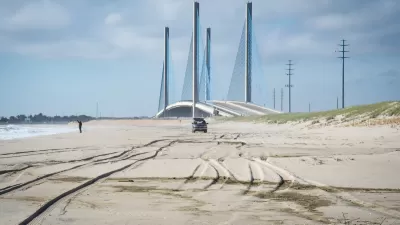As the destructive force of Hurricane Sandy demonstrated, all sand dunes are not created equal. But as coastal communities start to rebuild their defenses for the next storm, they're trying to close the gap with Mother Nature.
Hurricane Sandy made the value of natural defenses much more apparent to coastal communities throughout the Northeast. According to Katie Barnett, a specialist with the New Jersey Department of Environmental Protection, "The areas that had natural stable dune systems are the areas that survived the best. The areas that didn't have dune systems are the areas that really got wiped out."
Adam Cole looks at the ways that scientists and officials like Barnett are trying to improve the strength of man-made dunes. Take old Christmas Trees, for example. "The trees' needles and branches will trap windborne sand and serve as a foundation for new dunes." However, notes Cole, "[p]iles of sand — even those anchored by Christmas trees — will erode much faster than natural dunes."
"Natural dunes are strong, but they take a long time to grow."
"I would say ... a decade," says Norbert Psuty, a retired professor from Rutgers University.
"You might have to wait until 2023 for your dune system to fully recover from Sandy," adds Cole. But, "Island Beach State Park Manager Ray Bukowski says they don't have that kind of time."
"We can't sit and hope a dune gets re-formed here," Bukowski says. "We've got to jump-start the dune and let it start doing its thing."
FULL STORY: After Sandy, Not All Sand Dunes Are Created Equal

Planetizen Federal Action Tracker
A weekly monitor of how Trump’s orders and actions are impacting planners and planning in America.

Maui's Vacation Rental Debate Turns Ugly
Verbal attacks, misinformation campaigns and fistfights plague a high-stakes debate to convert thousands of vacation rentals into long-term housing.

San Francisco Suspends Traffic Calming Amidst Record Deaths
Citing “a challenging fiscal landscape,” the city will cease the program on the heels of 42 traffic deaths, including 24 pedestrians.

Defunct Pittsburgh Power Plant to Become Residential Tower
A decommissioned steam heat plant will be redeveloped into almost 100 affordable housing units.

Trump Prompts Restructuring of Transportation Research Board in “Unprecedented Overreach”
The TRB has eliminated more than half of its committees including those focused on climate, equity, and cities.

Amtrak Rolls Out New Orleans to Alabama “Mardi Gras” Train
The new service will operate morning and evening departures between Mobile and New Orleans.
Urban Design for Planners 1: Software Tools
This six-course series explores essential urban design concepts using open source software and equips planners with the tools they need to participate fully in the urban design process.
Planning for Universal Design
Learn the tools for implementing Universal Design in planning regulations.
Heyer Gruel & Associates PA
JM Goldson LLC
Custer County Colorado
City of Camden Redevelopment Agency
City of Astoria
Transportation Research & Education Center (TREC) at Portland State University
Jefferson Parish Government
Camden Redevelopment Agency
City of Claremont




























